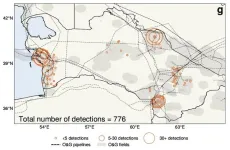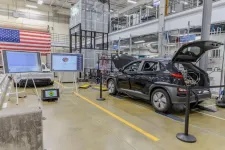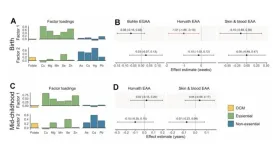(Press-News.org) Recent experiments by psychologists at Temple University and the University of Pittsburgh shed new light on how we learn and how we remember our real-world experiences.
The research, described in the March 12 online edition of Proceedings of the National Academy of Sciences (PNAS), suggests that varying what we study and spacing out our learning over time can both be helpful for memory — it just depends on what we’re trying to remember.
“Lots of prior research has shown that learning and memory benefit from spacing study sessions out,” said Benjamin Rottman, an associate professor of psychology and director of the Causal Learning and Decision-Making Lab at Pitt.
“For example, if you cram the night before a test, you might remember the information the next day for the test, but you will probably forget it fairly soon,” he added. “In contrast, if you study the material on different days leading up to the test, you will be more likely to recall it for a longer period of time.”
But while the “spacing effect” is one of the most replicated findings in psychological research, much of this work has been predicated on the idea that what you are trying to learn — the content of the experience itself — repeats identically each time. Yet that is rarely the case in real life, when some features of our experiences may stay the same, but others are likely to change. For example, imagine repeat trips to your local coffeeshop. While many features may stay the same on each visit, a new barista may be serving you. How does the spacing effect work in light of such variation across experiences?
In two experiments, Temple and Pitt researchers asked participants to repeatedly study pairs of items and scenes that were either identical on each repetition or in which the item stayed the same but the scene changed each time.
One of the experiments asked participants to learn and to test their memory via their smartphones — an unusual approach for learning and memory research. This enabled researchers to ask participants to learn pairs at various times of the day across 24 hours, more accurately representing how people actually learn information.
In the second experiment, researchers collected data online in a single session.
Emily Cowan, lead author on the PNAS paper and a postdoctoral fellow in Temple’s Adaptive Memory Lab, explained: “The combination of these two large-scale experiments allowed us to look at the timing of these 'spacing effects' across both long timescales — for example, hours to days — in Experiment No. 1 versus short timescales — for example, seconds to minutes — in Experiment No. 2. With this, we were able to ask how memory is impacted both by what is being learned — whether that is an exact repetition or instead, contains variations or changes — as well as when it is learned over repeated study opportunities.
“In other words, using these two designs, we could examine how having material that more closely resembles our experiences of repetition in the real world — where some aspects stay the same but others differ — impacts memory if you are exposed to that information in quick succession versus over longer intervals… from seconds to minutes, or hours to days.”
As in prior experiments, researchers found that spaced learning benefited item memory. But they also found that memory was better for the items that had been paired with different scenes compared with those shown with the same scene each time. For example, if you want to remember a new person’s name, repeating the name but associating it with different information about the person can actually be helpful.
“In contrast,” Rottman said, “we found that for associative memory — memory for the item and which scene it was paired with — benefited from stability. Spacing only benefited memory for the pairs that were repeated exactly, and only if there were pretty long gaps — hours to days — between study opportunities. For example, if you are trying to remember the new person’s name and something about them, like their favorite food, it is more helpful to repeat that same exact name-food pairing multiple times with spacing between each.”
The Pitt-Temple experiments represent basic memory research. “Because of how nuanced memory is, it is hard to provide clear advice for things like studying for a test because the sort of material can be so different,” Rottman said. “But in theory our findings should be broadly relevant to different sorts of tasks, like remembering someone’s name and things about them, studying for a test, and learning new vocabulary in a foreign language.
“At the same time, because all these sorts of tasks have lots of differences, it is hard to make really concrete advice for them. We would need to do follow-up research to provide more concrete guidance for each case.”
Cowan continued: “This work demonstrates the benefits of spaced learning on memory are not absolute, instead depending on the variability present in the content across repetitions and the timing between learning opportunities, expanding our current understanding of how the way in which we learn information can impact how it is remembered. Our work suggests that both variability and spacing may present methods to improve our memory for isolated features and associative information, respectively, raising important applications for future research, education, and our everyday lives.”
In addition to Cowan and Rottman, study investigators included Vishnu “Deepu” Murty, principal investigator of Temple’s Adaptive Memory Lab, and Yiwen Zhang, a graduate student in cognitive psychology at Pitt.
The research was funded by the U.S. National Science Foundation (grant No. 1651330) and the National Institutes of Health (grant Nos. NIH R21 DA043568, K01 MH111991 and R01 DA055259).
END
Study: Best way to memorize stuff? It depends...
2024-03-12
ELSE PRESS RELEASES FROM THIS DATE:
Exploring arctic plants and lichens: An important conservation baseline for Nunavut’s newest and largest territorial park
2024-03-12
Encompassing over 16 000 km2 of towering mountains, long fiords, lush valleys, and massive ice caps, Agguttinni Territorial Park is a protected area on northern Baffin Island, Nunavut, Canada. This park, and all of Nunavut, is Inuit Nunangat – Inuit homeland in Canada – and the park protects sites and biodiversity stewarded by Inuit since time immemorial.
Agguttinni means “where the prevailing wind occurs” in the Inuktitut local dialect. The park includes important bird areas, key habitats for polar bears and caribou, and numerous important Inuit cultural sites. It is very remote: no roads lead to it, and access ...
Multiple organ attack and immune dysregulation: Study reveals how the chikungunya virus leads to death
2024-03-12
The chikungunya virus, transmitted by Aedes aegypti and Aedes albopictus mosquitoes and responsible for more than 900 deaths in Brazil since it arrived around ten years ago, is capable of spreading through the blood, reaching multiple organs and crossing the blood-brain barrier, which protects the central nervous system. The mechanisms of action observed for the first time in fatal cases by a group of Brazilian, American and British researchers were reported in an article published on March 12 in the journal Cell Host & Microbe. The findings reinforce the need ...
Setting realistic expectations for recovery after robotic lung surgery
2024-03-12
Are surgeons giving patients unrealistic expectations about recovery after robotic lung surgery? That’s what CU Department of Surgery faculty member Robert Meguid, M.D., MPH, and surgery resident Adam Dyas, M.D., set out to discover after realizing the guidance they were offering patients might be based on outdated or anecdotal information.
“Traditionally, in surgery, we're taught to tell patients that they'll be back to normal from surgery within six weeks,” says Meguid, professor of cardiothoracic ...
UCF researchers lead $1.5 million project to improve efficiency of solar cells
2024-03-12
ORLANDO – A team of researchers from the University of Central Florida and the University of Delaware’s Institute of Energy Conversion has received a $1.5 million grant from the U.S. Department of Energy Solar Technologies Office to develop a novel metallization process that could improve the efficiency and lower the cost of solar cells, making solar energy more accessible to consumers.
The metallization process produces the metal contacts that are placed on the surface of silicon solar cells to ...
AI analysis of historical satellite images show USSR collapse in 1990s increased methane emissions, despite lower oil and gas production
2024-03-12
The collapse of the former Soviet Union in 1991 had social, political and economic effects worldwide. Among them was a suspected role in slowing human-generated methane emissions. Methane had been rising steadily in the atmosphere until about 1990. Atmospheric scientists theorized that economic collapse in the former USSR led to less oil and gas production, and thus a slowdown in the rise of global methane levels, which has since resumed.
But new University of Washington research uses early satellite records to dispute that assumption. The study, published March 12 in the ...
Charging up the commute
2024-03-12
A team of researchers at Oak Ridge National Laboratory demonstrated that a light-duty passenger electric vehicle can be wirelessly charged at 100-kW with 96% efficiency using polyphase electromagnetic coupling coils with rotating magnetic fields.
ORNL’s patented system transferred power to a Hyundai Kona EV across a five-inch airgap using electromagnetic fields, a process similar to the wireless charging of small consumer devices.
“We’ve achieved the highest power density in the world for a wireless charging system for this class of vehicle,” ORNL’s Omer Onar said. “Our ...
$5 million grant bets on computational biology, AI to change the future of cancer
2024-03-12
SAN FRANCISCO—A multidisciplinary research team at Gladstone Institutes, led by Senior Investigator Katie Pollard, PhD, has received $5 million in funding through a newly launched grant program designed to ignite a fresh wave of cancer discoveries using computational biology and artificial intelligence.
The new Transformative Computational Biology Grant Program from the Biswas Family Foundation, in partnership with the nonpartisan think tank Milken Institute, is providing a total of nearly $14 million to five research groups.
At Gladstone, the grant establishes ...
Integrating renewables and machine learning for improved grid stability
2024-03-12
In the race to achieve a net-zero future based on clean energy, renewable energy sources like solar and wind power have emerged as potential champions in the battle against climate change. However, as traditional synchronous generators are replaced by inverter-based renewable energy resources, the transition creates a low-inertia challenge within the existing power grids leading to stability and reliability concerns.
Xingpeng Li, assistant professor of electrical and computer engineering at the University of Houston, is working on a solution that will allow seamless integration of renewable energy ...
Global ecosystem contribute trillions in its services with key synergies and trade-offs
2024-03-12
Trade-offs and synergies between ecosystem services constitutes an important topic in ecosystem management. The value of each service is substantially influenced by human activities, and changes will affect human decisions. Given the variability in trade-offs and synergies, the simultaneous optimization of multiple ecosystem services presents a considerable challenge.
In a study published in Environmental Science and Ecotechnology, a team from the Chinese Academy of Environmental Planning, which has completed ...
Association of prenatal vitamins and metals with epigenetic aging at birth and in childhood
2024-03-12
“[...] our findings support the hypothesis that the intrauterine environment, particularly essential and non-essential metals, affect epigenetic aging biomarkers across the life course.”
BUFFALO, NY- March 12, 2024 – A new research paper was published in Aging (listed by MEDLINE/PubMed as "Aging (Albany NY)" and "Aging-US" by Web of Science) Volume 16, Issue 4, entitled, “Associations of prenatal one-carbon metabolism nutrients and metals with epigenetic aging biomarkers at birth and in childhood in a US cohort.”
Epigenetic gestational age acceleration (EGAA) at birth and epigenetic age acceleration (EAA) in childhood may be biomarkers of ...





